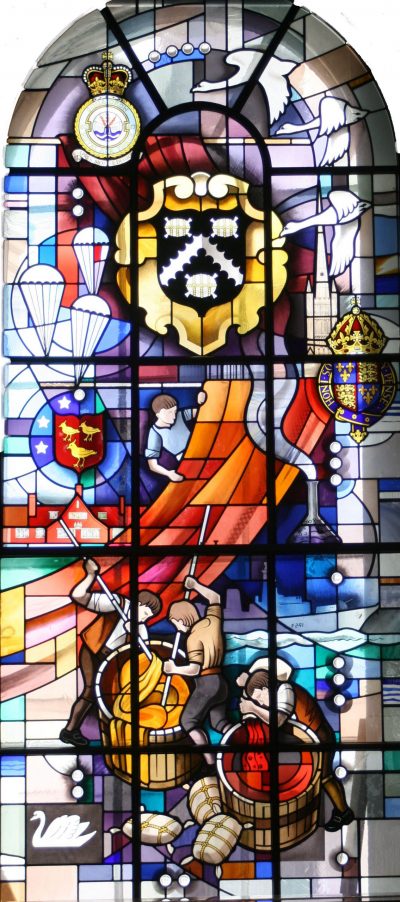Our History
The Millennium Window
This superb stained glass window was created by Mr J N Lawson of Goddard & Gibbs Studios Ltd. The contemporary design is intended to represent the activities and affiliations of the Company:
The main feature is the dyers at their vats. In the lower vat a dyer prepares red dye from the madder plant. The vat above shows cloth being dyed, using long poles to ensure the material is thoroughly immersed and the dye evenly distributed. Above this dyed material is hung out to dry. In the top centre panel is the shield from the Company’s coat of arms, showing three corded sacks – the traditional way of carting and storing dyestuffs.
Around this central theme, the artist has included symbols of the Company’s military and educational affiliations and charitable commitments.
The left hand middle pane depicts the Company’s almshouses at Crawley with the arms of Sir Robert Tyrwhitt above with the ‘Three Stars’ referring to his gift of property in Upper Thames Street in 1545. In the panel above three parachutists illustrate our affiliation with The Parachute Regiment, and above them again is the crest of 617 Squadron RAF, the legendary ‘Dambusters’ squadron.
The swans symbolise the Company’s ownership and continuing care of swans on the Thames. Below these are the arms of King Edward VI and the outline of Norwich Cathedral – both symbolising our connection with the Norwich School. Below this again is a chemist’s retort – a laboratory vessel – containing ‘Perkin’s Mauve’, the world’s first synthetic aniline dye discovered by William Perkin, underlining our close connections with the School of Colour Chemistry at Leeds University.
The next pane down on the right hand side includes the forepart outline of a Royal Navy Frigate. This symbolizes our naval links which began with HMS Brilliant in 1987, continued with HMS Grafton and now moves forward with HMS Vanguard.
The bottom left pane features the battle flag of 30th Signals Regiment who complete our military affiliations.
